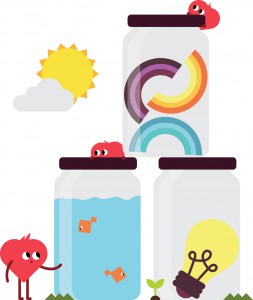The Science of Optimism: a Conversation on ‘The Optimism Bias’ with neuroscientist Tali Sharot
 I like to think of myself as a positive and optimistic person. It seems to me to make for an easier and more enjoyable journey through life. So I was intrigued when I read of neuroscientist Tali Sharot’s research into the Optimism Bias, which has shown that despite all the bad news stories we are bombarded with on a daily basis: war, violence, wrong-doing and financial meltdown, the majority of us are optimistic by nature; our brains are hardwired to be so. It’s a fascinating concept and one I had to find out more about, so I bought the book and met with Tali in her office at University College London for an enthralling discussion.
I like to think of myself as a positive and optimistic person. It seems to me to make for an easier and more enjoyable journey through life. So I was intrigued when I read of neuroscientist Tali Sharot’s research into the Optimism Bias, which has shown that despite all the bad news stories we are bombarded with on a daily basis: war, violence, wrong-doing and financial meltdown, the majority of us are optimistic by nature; our brains are hardwired to be so. It’s a fascinating concept and one I had to find out more about, so I bought the book and met with Tali in her office at University College London for an enthralling discussion.
What is optimism?
Firstly, to set the context, some definitions: Hope is what you want to happen. Optimism is the belief that the outcome you hope for will happen. The Optimism Bias is the over-prediction of positive outcomes. We are not aware of whether our hopes and predictions are realistic or not, it is a subconscious process and is linked to our ability to mentally imagine the future.
How does it work?
We expect outcomes to be better than they are likely to be in reality. As individuals we underestimate our chances of getting divorced (perhaps otherwise we would never get married), or being diagnosed with serious illness; whereas we expect our children to be super-talented and our careers to be more successful than our friends and peers. This clearly cannot be true of us all.
So what are the psychological and physiological factors which make this happen?
Tali stumbled into this area of research by accident. Studying how emotion changes memory, specifically traumatic memories such as in 9/11, it emerged that people’s memories of these events were filled with errors and inaccuracies. This is partly because the neural system involved in the processes by which you remember the past, are the same ones you use to imagine the future. It is designed to help us construct future scenarios in our mind, and so memory ends up being a partly constructed process too.
Tali talks generally about a self-fulfilling prophecy attached to the Optimism Bias: “If you expect to do well, that motivates you to act so you put in more effort and more hours therefore are more likely to succeed. If you don’t think you are going to win the race, get the promotion or beat the cancer accordingly you put in less effort. Our prediction of the future influences our actions, which in turn determine the outcome”.
Can the Optimism Bias be harnessed in healthcare?
When it comes to health promotion and education it is important to change the way we communicate the hazard. Most awareness campaigns are ‘fear campaigns’; Don’t smoke: you will get lung cancer. Don’t sit in the sun; you will get skin cancer. Wear a cycle helmet: if you don’t and you are in an accident you will die, despite evidence showing that these campaigns have only minimal impact.
This is the wrong approach because people disregard it. Smokers believe that smoking leads to lung cancer but because of their Optimism Bias they don’t believe that they will get lung cancer. How about rethinking the message? Why not put a positive message on cigarette packets to harness the Optimism Bias , for example, ‘80% of people are able to kick the habit after 2 weeks of trying’, or more informative messages such as ‘Visit this website to check your lung health’.
Surely the same theory can be applied to marketing approaches too. If we can better align with our customers’ innate optimism then surely they will better engage with our messages and connect with our brands.
The downside of seeing the upside
I am sometimes accused of being overly optimistic (heaven forbid!). According to Tali this can cause issues at both an individual and societal level.
Economists partly attribute the 2008 financial crash to the Optimism Bias within different stakeholder groups in the global financial market, including investors, analysts and government officials. When Optimism Biases from multiple sources come together, that can be dangerous and as in the financial sector, have explosive consequences.
When forecasting future results and scenarios we can be overly optimistic, and group-thinking can further add to the bias. How do you prevent this from happening? Awareness of the Optimism Bias is the first step. It enables you to make corrections. If you have a proxy you can review previous forecasts to get a picture of the level of inherent bias in your organisation. The UK Treasury Department’s guidance recommends that budgets for major projects include a contingency to allow for Optimism Bias; they counteract the tendency for project costs to be underestimated, ranging from 10 to 23.5%. London 2012 Olympic planning included an optimism formula to help guide their planning predictions.
On an individual level we should beware too. Overly positive assumptions can lead to terrible decision making. Extreme optimists do not believe that negative events will happen to them. It makes them less likely to get health check-ups or apply sun cream, and more likely to engage in risky behaviours and activities such as smoking and drinking and they can make bad, high risk investment decisions. Consequently, although mild optimists live longer, extreme optimists do not. It is a fine line to tread.
In conclusion
There is growing evidence that optimism may be hard-wired into our minds, and impacts all of our behaviours. Our brains aren’t just shaped by past events; they are driven by our hopes for the future. Further understanding of the impact and processes of the Optimism Bias could be harnessed in many fields including healthcare, psychology, behaviour change and marketing strategy, and that leaves me feeling rather optimistic.
 David Coleiro is a founding partner at www.strategicnorth.com, and this interview is an extract from the book Strategic Tales by Strategic North. To request your free copy please email them at info@strategicnorth.com.
David Coleiro is a founding partner at www.strategicnorth.com, and this interview is an extract from the book Strategic Tales by Strategic North. To request your free copy please email them at info@strategicnorth.com.
 For more information on Tali Sharot and her work visit www.theoptimismbias.com
For more information on Tali Sharot and her work visit www.theoptimismbias.com
Related articles:


